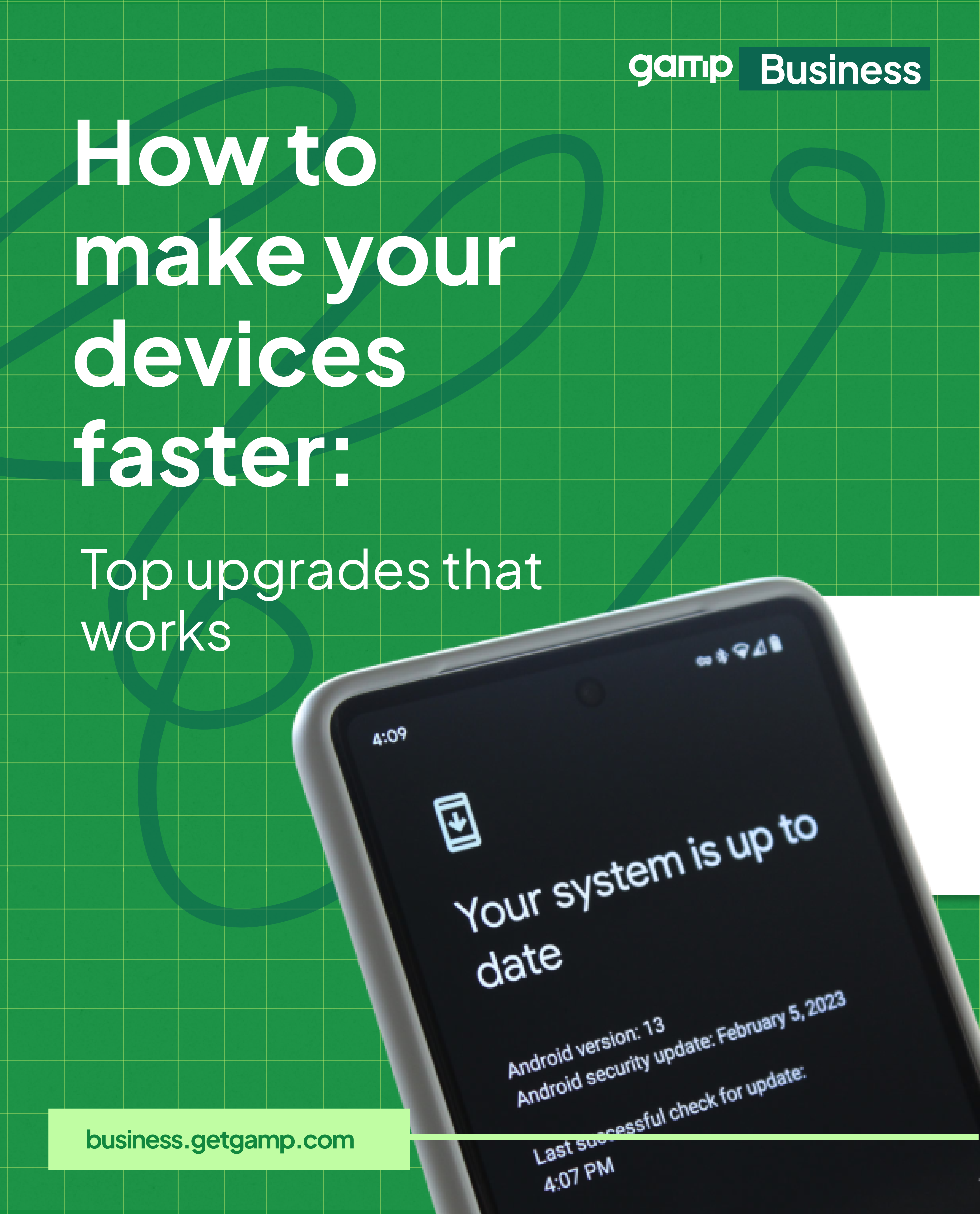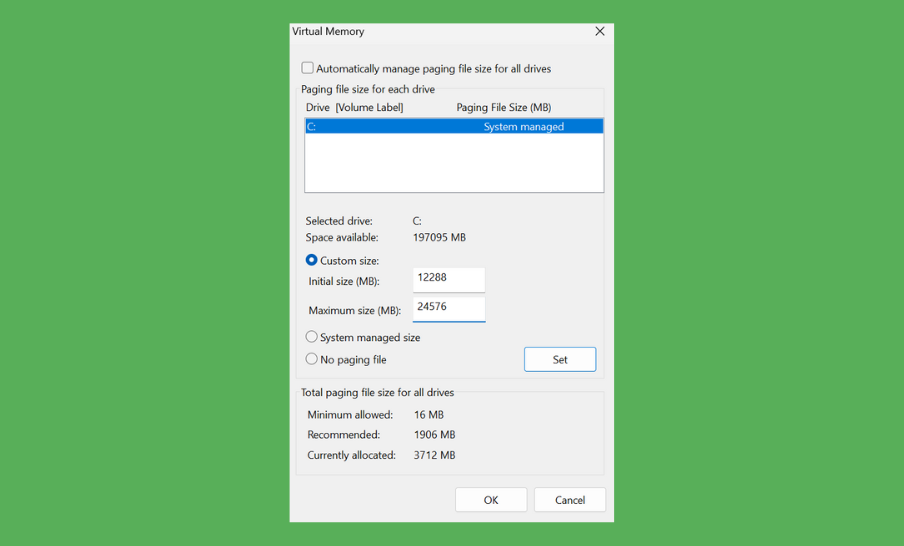How to make your devices faster: Top upgrades that work

Few things are more frustrating than a slow device.
Whether it's your laptop lagging during work or your phone freezing mid-call, poor performance cists you time and productivity. The good news? You don't always need a new device- a few smart upgrades can make your gadgets feel brand new
This guide covers essential tips so you can get better performance out of your device.
Let’s turn your slow laptop into a speed machine. 🚀

Instant ways to speed up your laptop
If your laptop is running slow, you don’t always need a major fix. Let’s start with four simple things you can do right now.
1.. Restart properly
It sounds too simple to be true, but restarting your laptop can instantly improve performance. But most people don’t restart properly.
They'd just close the lid or press shut down. When we are not fighting? There's a restart menu on your laptop, and you should use that.
A proper restart will clear the system memory, reset background processes, and apply important updates.
- Click the start menu (Windows;) or Apple logo (Mac).
- Select Restart (not shut down).
- Wait for your laptop to fully reboot before using it again.
Try it now; you might notice a difference right away.
2. Stop background apps
Your laptop runs a lot of apps in the background. This eats into your memory space and contributes to the slow performance.
You don't even have to use an app before it starts running in the background as most apps do this automatically.
What should you do? Check your background apps and shut down the ones you don’t need.
On Windows PC:
- Press Ctrl + Shift + Esc to open Task Manager.
- Click on the Processes tab.
- Look for apps with high CPU or memory usage.
- Right-click on unnecessary apps and select End Task.
On Mac:
- Press Command + Spacebar and type Activity Monitor.
- Click on the CPU tab.
- Find apps using a lot of power and click the X button to close them.
3. Free up storage
Your laptop slows down when your storage is almost full, but you don’t need to delete everything. Just clean out these three folders:
The downloads folder
- Open your downloads folder and delete old files you don’t need.
- Sort by size to remove the biggest space-wasters first.
The temp files folder (Windows users only)
- Press Windows + R, type %temp%, and press Enter.
- Select all files and delete them.
The recycle bin/trash
Empty your Recycle Bin (Windows) or Trash (Mac) to permanently delete files.
Bonus tip: Run a storage analyzer tool (like Windows Storage Sense or Mac Storage Management) to see what’s taking up the most space.
Check your task manager
If your laptop feels slow, Task Manager (Windows) and Activity Monitor (Mac) can show you exactly what’s causing the problem.
For Windows Users:
- Press Ctrl + Shift + Esc to open Task Manager.
- Click the Performance tab to check CPU, Memory, and Disk usage.
- Sort by Highest usage and end tasks that are slowing your system.
For Mac Users:
- Press Command + Spacebar, type Activity Monitor, and open it.
- Check the CPU and Memory tabs.
- If an app is using a lot of power, select it and click the X button.
Optimize windows/macOS for peak performance
If you want long-term speed improvements, tweaking your Windows or macOS settings can make a huge difference.
For Windows Users
- Use Windows performance mode
By default, Windows balances performance with energy savings, which isn’t always ideal. Switching to high-performance mode can give you a speed boost.
How to enable High-Performance Mode:
- Open the Start Menu, type Power, Sleep and Battery Settings, and open it.
- Scroll to Power.
- Select Best power efficiency or Best Performance under power mode.
- Turn off unnecessary startup apps
Some apps automatically launch when you start your laptop, making boot times painfully slow.
How to disable startup apps:
- Press Ctrl + Shift + Esc to open Task Manager.
- Click the Startup tab.
- Look for apps with High startup Impact and disable the ones you don’t need.
3. Run disk cleanup & defragmentation
Over time, Windows collects junk files that slow things down. Running Disk Cleanup and Defrag helps keep things running smoothly.
To run Disk Cleanup:
- Open File explorer, right-click your C: Drive, and select Properties.
- Click Details and you will be shown how your storage is used. You can then go ahead and remove files to free up space.
To defragment your drive (HDD users only):
- Type Defragment and Optimize Drives into the Start menu and open it.
- Select your HDD and click Optimize.
Note: If you have an SSD, do NOT defrag. it’s unnecessary and can shorten the lifespan of your drive.
4. Use ReadyBoost (Windows)
If your laptop has low RAM, you can use a USB flash drive as additional memory using ReadyBoost.
How to enable ReadyBoost:
- Insert a fast USB drive into your laptop.
- Right-click the USB drive in File Explorer and select Properties.
- Click the ReadyBoost tab and enable it.
For Mac Users
1. Reduce transparency & animations
MacOS uses fancy animations that look nice but slow things down. Turning them off makes everything snappier.
How to disable animations:
- Go to System Settings > Accessibility > Display.
- Enable Reduce Motion and Reduce Transparency.
This makes your Mac feel faster, especially on older models.
2. Manage startup apps
How to disable startup apps on Mac:
- Open System Settings > Users & Groups.
- Click Login Items
- Select unnecessary apps and click the - (minus) button to remove them.
3. Use Activity monitor
Activity monitor helps you find which apps are hogging resources.
How to use activity monitor:
- Open Spotlight Search (Command + Spacebar) and type Activity Monitor.
- Click the CPU tab and find apps using the most power.
- Select unwanted apps and click the X button to close them.
Software tweaks to boost laptop speed
When your laptop starts feeling sluggish, it’s not always the hardware’s fault. Software tweaks can help speed things up too. Here is how to get started.
Update drivers
Think of drivers as the middlemen between your hardware and software. When they’re outdated, your laptop struggles to run efficiently.
Why it matters:
- Old drivers can cause slow performance, crashes, and even overheating.
- New updates include speed improvements, security patches, and bug fixes.
How to update drivers on Windows:
- Press Windows + X → Select Device Manager.
- Expand categories like Display Adapters, Network Adapters, and Disk Drives.
- Right-click on a device → Click Update Driver → Choose Search automatically.
How to update drivers on Mac:
macOS handles most updates automatically. Just go to System Settings → General → Software Update and install any pending updates.
Upgrade your browser
Your web browser is one of the biggest resource hogs on your laptop. Here’s how to make it run faster and smoother.
For Chrome & Edge:
- Turn on hardware acceleration (Settings → System → Use hardware acceleration when available).
- Reduce extensions (Too many add-ons slow things down—keep only the essentials).
- Clear cache & cookies (Go to Settings → Privacy → Clear browsing data).
For Safari:
- Disable unnecessary extensions (Safari → Settings → Extensions).
- Enable website restrictions to block auto-playing videos.
- Use Content Blockers to stop slow-loading ads.
Use lightweight software alternatives
Some software are too heavy for normal use. Switching to lightweight alternatives can free up RAM and CPU power.
Heavy vs. Lightweight Software
RAM & storage optimization
Your laptop’s RAM and storage determine how many tasks it can handle at once. Here’s how to optimize them for maximum speed.
How to know if you need more RAM
Before spending money on a RAM upgrade, check if your current RAM is maxed out.
1-minute test to check your RAM usage
- Windows: Open Task Manager (Ctrl + Shift + Esc) → Go to Performance → Memory.
- Mac: Open Activity Monitor (Cmd + Space → Search ‘Activity Monitor’) → Click Memory tab.
If RAM usage is above 80% most of the time, you probably need an upgrade.
How much RAM do you actually need?
- 4GB – Basic tasks (web browsing, documents).
- 8GB – Light multitasking (Zoom, Chrome, MS Office).
- 16GB – Heavy multitasking, gaming, video editing.
- 32GB+ – Professional-level work (3D design, advanced video editing).
Boost performance without buying new RAM
If you can’t upgrade your RAM, try these tricks to make the most of what you have.
1. Increase virtual memory (Windows) Virtual memory (pagefile) acts like extra RAM by using storage space.
- Go to Settings → System → About → Advanced System Settings → Performance → Advanced.
- Click "Change" under Virtual Memory → Uncheck “Automatically manage paging file”.
- Set Initial Size = your RAM size x 1024 x 1.5
- Max Size = your RAM size x 1024 x 3.
- Click Set → OK → Restart your laptop.

2. Disable startup programs Too many apps launching at startup slow down your laptop.
- Windows: Open Task Manager (Ctrl + Shift + Esc) → Go to Startup tab → Disable unnecessary apps.
- Mac: Go to System Settings → General → Login Items → Remove unnecessary apps.
Storage optimization: SSD vs. HDD
Your storage directly affects boot speed, app loading times, and overall performance.
If you’re still using an HDD, upgrading to an SSD is the single best speed boost you can get.
Troubleshooting when your laptop is still slow
So, you’ve tried everything; closed background apps, cleared storage, updated drivers and your laptop is still crawling like a snail on a hot day.
What now? Let’s see other issues.
Sometimes, the real problem isn’t what you’re running, but what’s running against you.
Here are the three biggest laptop killers and how to deal with them.
Malware & viruses
Malware can secretly hijack your laptop’s resources, causing slowdowns, overheating, and even data theft.
Signs you have malware:
- Your fan is running non-stop even when nothing’s open.
- Web pages are loading slower than usual (even with good Wi-Fi).
- You’re getting pop-ups or weird redirects in your browser.
How to fix it:
- Run a full malware scan
Windows: Use Windows Defender (Settings → Update & Security → Windows Security).
Mac: Use Malwarebytes for Mac (download from their official site).
- Check task manager (Windows) or activity monitor (Mac)Look for unknown apps using too much CPU. If you see something suspicious, Google the process name.
- Uninstall suspicious apps
Windows: Control Panel → Programs & Features
Mac: Finder → Applications → Move to Trash
Dying hard drive
If your laptop is still running on an old HDD (hard disk drive), that might be the problem. HDDs slow down over time and eventually fail completely.
Signs your hard drive is failing:
- Frequent crashes and freezing
- Clicking or grinding noises from the laptop
- Files take forever to open or save
- Windows shows “S.M.A.R.T.” errors
How to check your hard drive health:
Windows: Open Command Prompt (Windows + R → type “cmd”) and enter:
“wmic diskdrive get status.” If it says “Caution” or “Bad,” your HDD is dying.
Mac: Open Disk Utility → First Aid to check drive health.
Best fix: Replace your HDD with an SSD. A solid-state drive (SSD) makes your laptop 10x faster instantly.
Overheating issues
Overheating slows your laptop down and can permanently damage your hardware.
Signs of overheating:
- Your laptop randomly shuts down
- The fan is super loud all the time
- Your keyboard or bottom panel feels burning hot
How to fix it:
- Clean your laptop’s vents & fans using compressed air or a small brush to remove dust.
- Reapply thermal paste (for advanced users) to refresh the cooling system and improve heat transfer.
- Get a cooling pad to keep air flowing underneath your laptop, reducing heat.
Clean Windows/macOS installation
If all else fails, it’s time for the ultimate fix—a clean reinstall of your operating system. This wipes out every unnecessary app, virus, and broken file, making your laptop as fast as new.
How to reset Windows
- Go to Settings → System → Recovery.
- Under Recovery options, click Reset PC.
- Choose Remove Everything for a full reset.
- Follow the prompts, and Windows will reinstall itself.
How to Reset macOS
- Restart your Mac and hold Command (⌘) + R until you see the Apple logo.
- Select Disk Utility → Erase your Mac’s drive.
- Close Disk Utility, then click Reinstall macOS.
- Follow the setup instructions.
Pro Tip: Before resetting, backup your important files to an external drive or cloud storage.
Final thoughts
By now, you’ve got all the tools to make your laptop run faster, smoother, and better than ever. But before you go, here’s a quick-action checklist to get started today.
The 80/20 rule of laptop performance optimization
80% of your speed boost comes from 20% of fixes.
- Upgrade to an SSD (Biggest speed improvement!)
- Uninstall unnecessary apps & stop background processes
- Keep your laptop cool & clean
A quick-action checklist
✅ Restart your laptop properly
✅ Open Task Manager/Activity Monitor and close useless apps
✅ Free up storage (clear downloads & temp files)
✅ Run a malware scan
✅ Check if you need an SSD or RAM upgrade
If it’s beyond what you can optimise, get fast and affordable repairs with gamp today.

